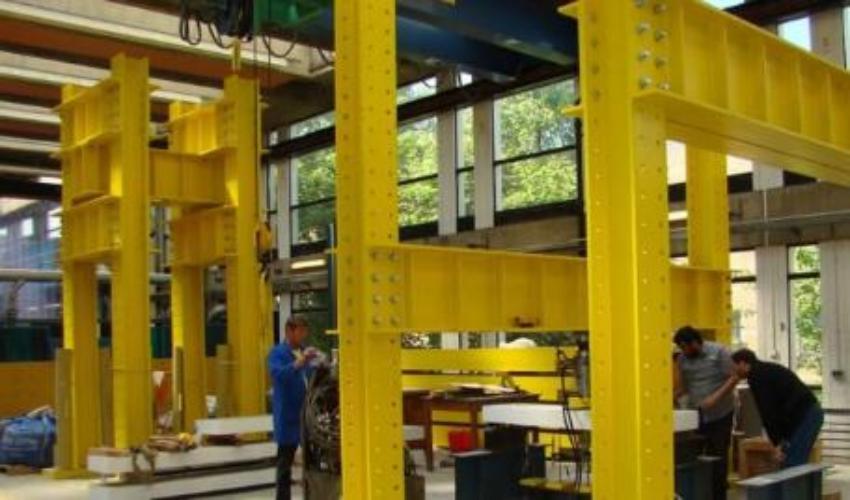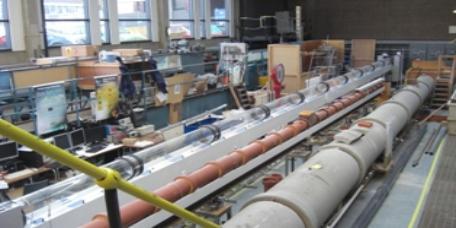Facilities at the Centre for Sustainable Environments
Heavy structures laboratory
The Civil Engineering Research Facility consists of a dedicated laboratory facility. The testing laboratory is dedicated to research and development work, encompassing both empirical and numerical testing/design programmes.
The heavy structures laboratory hold one of the largest strong floor in the UK. The Faculty have invested over £500,000 into the facilities of the heavy structures laboratory, including a main ring hydraulic system with twin pumps capable of delivering 300l/min of hydraulic power; it would allow full-scale experimental studies on structures up to 15 metres long in static, dynamics and impact loading. Several Servo-controlled actuators and control systems were acquired together with a series of loading frames with capacity up to 5,000kN.
The research group has been very successful in recent years, obtaining a number of research grants from highly regarded UK funding agencies, namely the Engineering and Physical Sciences Research Council (EPSRC) and the Department of Trade and Industry (DTI), together with industrial consultancy projects. Collectively the group has received awards in advance of £750k in the last 5 years.

Heavy structures laboratory
Recent projects
- Development of a novel water purification system using plant extracts for developing countries
- The use of novel vegetable fibre geotextiles to reinforce and reinstate contaminated soils
- Improving the performance of unpaved roads in Africa
- Performance of lime mortars in masonry
- The use of thermally desorbed soils in concrete and mortars
- Fire resistance of masonry structures
- Sustainability and the sustainable use of building materials
- Structural behaviour of long span steel concrete composite structures
- Behaviour of shear connectors
- Behaviour of concrete filled composite columns
- Fire engineering of steel and composite structures
- Robustness and prevention of progressive collapse to steel and composite structures
Acoustics laboratory
The Acoustics Laboratory offers a wide range of services specifically designed to support you in developing and optimising noise control solutions.
Our technical experts employ state of the art facilities to deliver bespoke solutions in the areas of:
- Sustainable acoustic materials
- Noise control applications
- Noise measurements

Acoustic tests available
| Test Standard | Details |
|---|---|
| ISO10534-2 | Determination of sound absorption coefficient and impedance in impedance tubes |
| BS EN 29052 | Method for the determination of dynamic stiffness. Materials used under floating floors in dwellings. |
| ISO 9053 | Materials for acoustical applications - Determination of airflow resistance. |
| Non-Standard Tests | Details |
| ALT1 | Standing wave tube transmission loss. |
| ALT2 | Material damping and loss factor. |
| ALT3 | Impact sound isulation testing. |
| ALT4 | Full micro-structural characterisation of porous media (Biot parameter characterisation). |
| ALT5 | Dynamic analysis. |
| ALT6 | Subjective evaluation of sound quality. |
| ALT7 | Industrial/ work place noise assessment. |
| ALT8 | Environmental noise assessment. |
| ALT9 | Marine and Offshore noise consultancy. |
| ALT10 | Acoustic material design and optimisation. |
| ALT11 | Product acoustic performance assessment. |
| ALT12 | Applications development and noise control treatment. |
Hydraulics laboratory
The Hydraulics Laboratory, which is one of the largest in the UK, has the capacity of providing flow rates in excess of 120 litres per second to an assorted size of pipes, located in the 25m x 5m physical modelling area.
The laboratory's staff specialise in the design, build and interpretation of model studies involving sediment and solid transportation. They also have the capability of carrying out computational fluid dynamic (CFD) studies and have access to full scale pipe test facilities that can be used for flow measurement, testing and calibration.
Recent industrial collaborations have included working with London Underground and Mouchel plc. The laboratory has attracted significant funding from EPSRC and from other funding bodies, including the EU, DTI and Yorkshire Water.

